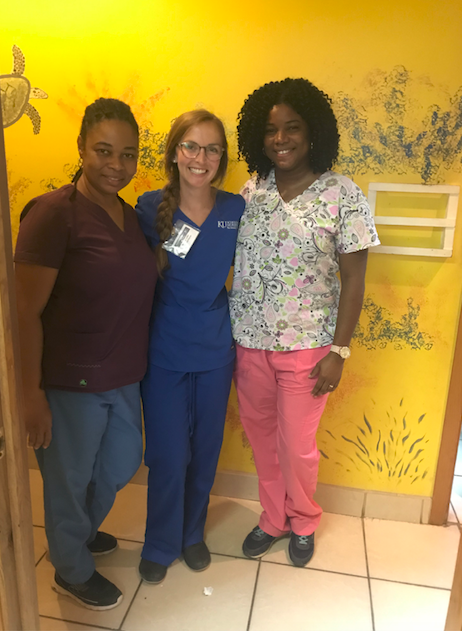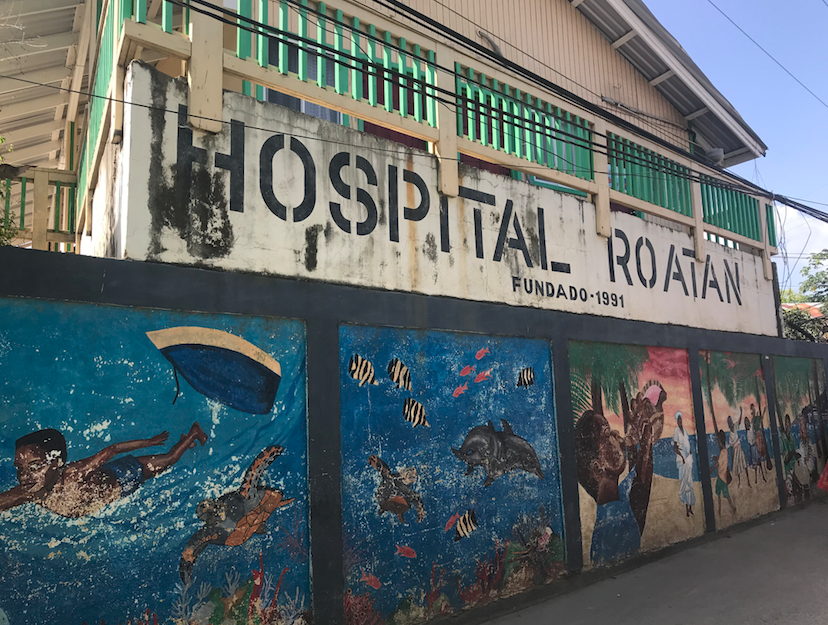(Belated) Week 2
July 9th, 2019 by Rachel Loder
Week 2 flew by at Clínica Esperanza! I was assigned to the adult triage/treatment area of the clinic, and really enjoyed my experiences learning from the nurses, Kendy and Aydelette. There are more doctors in the adult area, thus a higher volume of patients to triage/treat, which made each day fly by. Between the motorcycle accident wound treatments, bilateral ear irrigations, IM antibiotic injections, HHS, preeclampsia, a toenail removal, and dengue treatment there was a lot to observe and assist with! I am very thankful to Kendy and Aydelette for taking time to explain procedures/diagnosis to me and for allowing me to participate alongside them in caring for the wide array of patients last week.

Though my first year of nursing school was full of pathophysiology, pharmacology, etc, I truly believe the single best thing I learned was Professor Gay’s line, “arrange your face.” This simple and direct phrase has helped me breeze through situations where my gut reaction is a grimace/gag/gasp (or at to least maintain my composure until I am far enough away to let my facial muscles react). While watching Doctora Andino seamlessly remove a very ingrown toenail, I used that clutch line as my steadfast mantra while also feeling absolutely impressed with 1) the efficacy of lidocaine—what a gem and 2) the patient’s stoic manner as he watched the entire procedure without a single comment or flinch. I recognize that I’m clearly still a rookie to direct patient care, but boy have I come a long way since the first time I shadowed a nurse and passed out approximately 10 minutes into the experience!
Next on my rambling blog agenda: touring the public hospital. While the topic of access to healthcare in the U.S./privilege in general could be discussed, analyzed and debated for literal centuries on end, I would like to “go there” for a minute. Last Wednesday I had the opportunity to tour the local public hospital (government funded) with 2 other volunteers. The C.E. staff that took us reminded us to “arrange our faces” and not take photos of what they thought might be a shock to our (very privileged) U.S. lenses while observing the stark differences in resources, amenities, realities etc of the public hospital compared to what we’re used to at home. Since I had visited my host brother in a public hospital in Peru I was less shocked than what I would’ve been otherwise, but it was still extremely eye opening. I realize some of you reading this may have also spent time in or toured a government-funded hospital abroad and some might not. So, without getting lost in the aesthetic/technological/surface-level details, my general initial observations were obviously centered around the overall lack of resources. Patients and their families are responsible for buying most gauze, cotton balls, alcohol wipes, meals, saline, tubing, needles, etc—it’s essentially BYOS (bring your own supplies), equipped with technology that is probably considered about 30 years outdated by most U.S. standards. Yes, this poses a whole slew of difficulties when it comes to accessing care and treatment, and many evidence based practice scholars could crank out infinite dissertations on these problems associated with risk of infection, standards and quality of care, etc, but that’s not what struck me as the “shocking” part of the public hospital tour. (That’s not to say that EBP isn’t worth considering or maintaining even in low-resource settings)
What stood out to me is the simple truth that whether you’re in the beautiful new Cambridge towers at UKHS in Kansas City or at this hot, crowded hospital—medicine is medicine! And that’s exactly what the doctors, nurses, lab techs, aides, etc show up to do every day here in Honduras, even when they haven’t gotten paid in 2 months due to any number of governmental challenges. To serve their patients and do the absolute best they can with what they’ve got. To waste as little as possible. To be resourceful and creative in their approach to diagnosis and treatment with the limited resources available to them. No, they don’t have access to many supplies we would (thankfully) consider basic and essential in an emergency room at home in the U.S., but when someone wrecks their motorcycle on the windy, two-lane road on the island and ends up in Roatan’s public ER, those doctors, nurses, etc will provide thorough and effective care no matter what. They’re excellent at what they do despite the unimaginable challenges they face, and to assume anything less or spend too much time gawking at the lack of resources is a huge misjudgment. On the ride to the public hospital, I had mentally prepared myself for the aesthetic/surface-level “shocks” of what we might see. I didn’t even consider the potential to walk away thoroughly impressed by all that can be and IS done there on a daily basis around the clock, and that was my humbling error. I’m still reeling with respect for those healthcare professionals and the tough work they pull off every minute of every day!

Anyway, I’m continuing to be blown away by those from whom I get to learn every day (staff and patients) and genuinely loving this experience. How did I get so lucky?
My 8-year-old laptop is on its last leg and radiating so much fiery heat that I better take a hint and end my novel here. More to come later this week!
Currently reading: Body of Work (Meditations of Mortality From the Human Anatomy Lab) by Christine Montross.


Sorry, comments for this entry are closed at this time.